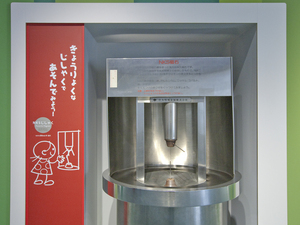Nagoya City Science Museum
TOP > Exhibition Guide > Keyword Search > Starting with "P" > powerful > Powerful Magnets
Powerful Magnets



Purpose of Exhibition
Place those nails closer to the NKS magnets. You will find that they are very powerful magnets. It can be said that the KS magnet steel, invented by Kotaro Honda in 1917, started the research and development of the most powerful and permanent magnets in the world. This magnet became well-known and Japan has played a leading role in the magnets field since then. KS is an acronym for Kichizaemon Sumitomo, who had funded the research. Thereafter, Hakaru Masumoto and Yuuki Shirakawa participated in the research and the NKS magnet steel was introduced in 1935. Its first letter "N" stands for "New". This is the magnet exhibited. It is made of iron, aluminum, nickel, cobalt, copper, and titanium. Also, this exhibit is one of the "Natsukashino Tenji (Exhibition from a Good Memories)", which had been on display before and was donated in 1974.
Additional Knowledge
<What Is Attracted to Magnets and What Is Not?>
Try finding something attractable to magnets around us. Iron products such as nails and needles can be attracted to magnets. How about Japanese coins? None of the coins used currently are attracted to magnets. It is only iron, cobalt and nickel that have magnetic nature (it is called ferromagnetism). But it is not always the case that substances including these minerals are attracted to magnets. The 500-yen, 100-yen, and 50-yen-coins are an alloy of nickel (25%) and copper, but are not attracted to magnets. Among iron chemicals, there are some that are attracted to magnets (e.g.iron sand and iron oxide) but others are not (e.g. pyrite). Stainless steel are some kind of alloys of iron, chromium, and other minerals, and there are some that are attracted but others are not. The latters, alloys added nickel to the formers, are rust-free and expensive steel. It is difficult to see how they could not be attracted to magnets. Try to see whether or not the stainless steel products such as, spoons and forks in your house can adhere to magnets.
[Why does iron adhere to magnets?]
When putting an iron nail with a magnet near another iron nail, they attract each other, don't they? Any substance attracted to magnets, when in a magnetic field, is transformed into a magnet itself. It could be said that iron and nickel are compounds of tiny magnets. Since the small magnets inside are usually in random directions, canceling out the effect of the magnetic field on each other, the whole does not work as a magnet. But, when a strong magnetic power is applied from outside, the small magnets inside are set in the same directions and the whole becomes magnetic. If an electric current flows, a magnetic field is produced. An electric current is a flow of electrons. Therefore, when electrons move, a magnetic field is created. However, other electrons surround electrons.
Due to the mutual interaction among electrons of adjacent atoms and electrons in other parts of an atom, canceling out the effect of mutual magnetic fields, there are many chances that small magnets cannot be produced. For ordinary iron such as alpha iron, its magnetic field remains without being canceled out and tiny magnets are created inside and attracted to other magnets. However, depending on the distance between atoms, their mutual interactions differ and a kind of iron called gamma iron, which is not attracted to magnets with different interval of atoms, can be made with a specific method.
Article by Keiko Ishida, curator
